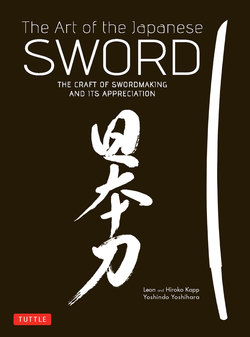Читать книгу The Art of the Japanese Sword - Yoshindo Yoshihara - Страница 8
На сайте Литреса книга снята с продажи.
ОглавлениеINTRODUCTION
by Leon Kapp
The Japanese sword, a singular work of art in steel, can be appreciated from a number of viewpoints. Its functionality as a weapon is remarkable, as are the sophisticated metallurgy and scientific thinking utilized by the swordsmith. Beyond the shape of the sword itself, among the most critical aesthetic elements are the different crystalline structures and forms in the steel.
Its use as a weapon over the ages means that the Japanese sword serves as a living example of the evolving technology used in its construction. There is also an intimate connection between the sword and Japanese history, as its features were shaped in response to historical events. Furthermore, it is fascinating to meet and learn from the modern-day craftsmen who still produce these blades.
The purpose of this book is to convey to the reader a basic background regarding the Japanese sword, as well as to explain how to view and appreciate a blade and to show the details of how a sword is made and finished today. Modern craftsmen use completely traditional methods from the past to prepare their steel, forge the sword, and create the distinctive hardened edge. Japan, it seems, is unique in the way it has maintained its traditional sword-making technology from ages past. Our hope is that by gaining a good understanding of how a sword is actually made, the reader will be able to appreciate the Japanese sword more fully.
Japan’s distinctive and sophisticated sword-making methods were perfected over hundreds of years, beginning sometime between the fourth and sixth centuries when swords and the technology to make them were first imported from China via Korea. Even today blades are still made using these time-tested techniques, which were preserved intact throughout the transition from the feudal past into the modern world. Beyond its superb functionality, part of the fascination of the Japanese sword is the fact that it is made from iron ore smelted in a charcoal-fueled furnace, using a bellows design that dates back approximately 2200 years. The steel is worked completely by hand with hammers and human labor, making each sword one-of-a-kind. Even with today’s modern knowledge of metallurgy, it is unlikely that a better steel sword can be made.
The Japanese sword is remarkable both as a weapon and as an object of art. Its design evolved over centuries to cut well and efficiently. The properties that make it so effective as a weapon also lend it compelling aesthetic qualities. It is not easy to observe all of the essential details, however. To be fully appreciated, a sword must be in good condition, with no rust on its surface. It must not be “tired”; that is, it must not be over-polished or have been poorly restored or repaired in the past, as such factors can ruin the shape and obscure details on the surface. Once these conditions are met, it is necessary to have proper lighting and to hold the sword at a proper angle relative to the light. Some knowledge of traditional viewing methods is a further necessity to proper appreciation of a blade’s qualities. As the Japanese swords one may see today are frequently in very poor condition, and proper lighting may not be available, simply examining and appreciating them can often be difficult.
The aim of this book is to provide a comprehensive introduction to the Japanese sword in order to help readers to examine and appreciate these inimitable works of art. It explains in detail the work of the swordsmith, along with that of other craftsmen who finish and mount the sword. The making of a Japanese sword is a long process: after the swordsmith makes the sword, it goes to a polisher for the final shaping and a polish that will bring out all of the details of the steel surface; it then goes to a craftsman who makes the habaki, a metal fitting that supports the hilt and secures the blade in the scabbard. Finally, the sword goes to a scabbard maker for a shirasaya (a simple wood scabbard designed to protect and preserve the sword), or for a traditional koshirae, the complete functional mounting.
Other topics covered in this text include an explanation of how to appreciate and handle a sword; descriptions of the smelting of the steel, the forging of the blade, and the finishing of the sword; a brief explanation of the metallurgy involved; and illustrations of the vocabulary used to describe the parts of the sword. Historical events, both ancient and modern, are also recounted in order to explain how traditional Japanese sword-making techniques from the past were preserved.
Most of the modern works shown in this book were made by Yoshindo Yoshihara and his family. The Yoshihara family has been active in making and promoting Japanese swords both in Japan and internationally. Yoshindo’s grandfather, the first swordsmith in the family, began making swords in the early 1930s in Tokyo, and was considered one of the best smiths working at that time. Yoshindo and his brother Shoji are the third generation in the family to make swords; Yoshikazu, Yoshindo’s son, represents the fourth generation.
A dagger by Yoshindo with a horimono (engraved carving) in the shape of a tiger.
An Edo-period painting showing a famous battle between Takeda Shingen and Uesugi Kenshin. Uesugi is striking at Takeda with his sword, while Takeda blocks the strike with an iron fan. From the collection of the Hiroshige Museum of Art, Ena, Gifu Prefecture. Reprinted with permission.
APPRECIATING THE JAPANESE SWORD
EXAMINING A JAPANESE SWORD - PAGE 15
SWORD CARE AND MAINTENANCE - PAGE 17
SWORD TERMINOLOGY - PAGE 25
EXAMINING THE HAMON - PAGE 40
THE STEEL AND STRUCTURE OF THE JAPANESE SWORD - PAGE 44
SWORD MOUNTINGS: KOSHIRAE AND SHIRASAYA - PAGE 51
THOUGHTS ON THE JAPANESE SWORD - PAGE 64
